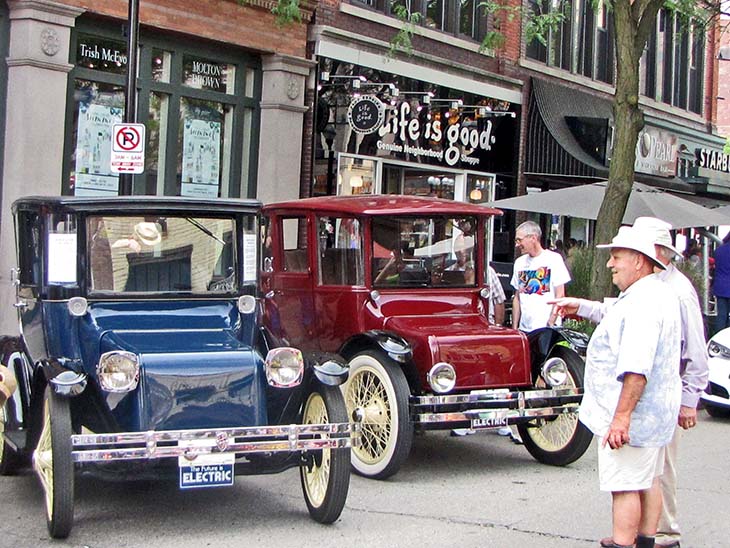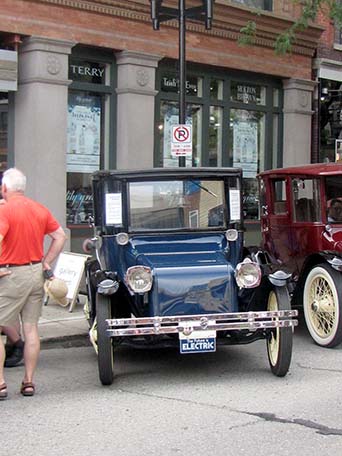

General Motors began assembling their electric vehicle, the Volt, in the Hamtramck Assembly plant in 2010. That factory is not more than two miles—as the crow flies—from the site you see pictured on this page. The Anderson Carriage company started building coaches and carriages in Detroit in 1883. As the nation’s urban population grew larger and more prosperous, individuals wished to have attractive, well-appointed horse-drawn coaches. The more financially successful had a livery man to drive their coach and tend their animals. Quite a number of Michigan firms prospered in the coach business. After 1900, many of these firms realized that the future was in a motorized vehicle, not one that depended upon the strength of Old Dobbin.
In the first decade of the last century, it was not certain how motor vehicles would be powered. Henry Ford, Ransom Olds and many other saw a future in gasoline powered vehicles. Steam power had been successfully used of the railroads and on ships for many decades. The Stanley firm  from Springfield, Massachusetts was briefly successful in selling many steam powered cars. They had a great advantage of not requiring the hand cranking that gasoline powered vehicles demanded but they had the disadvantage that you—or your house servant—had to build and tend a fire to get your vehicle on the road. The fire was fueled by petroleum so once you got underway, you did not face the challenges that a fireman on a steam rail locomotive dealt with. Apparently some customers feared a boiler explosion but the Stanley firm claimed that their safety devices were so effective that none of their boilers ever exploded. Steam-powered cars were complex machines and sold for much higher prices that gasoline-powered vehicles. By the mid-1920s the production of steam powered cars ceased.
from Springfield, Massachusetts was briefly successful in selling many steam powered cars. They had a great advantage of not requiring the hand cranking that gasoline powered vehicles demanded but they had the disadvantage that you—or your house servant—had to build and tend a fire to get your vehicle on the road. The fire was fueled by petroleum so once you got underway, you did not face the challenges that a fireman on a steam rail locomotive dealt with. Apparently some customers feared a boiler explosion but the Stanley firm claimed that their safety devices were so effective that none of their boilers ever exploded. Steam-powered cars were complex machines and sold for much higher prices that gasoline-powered vehicles. By the mid-1920s the production of steam powered cars ceased.
Electricity was the other option. New York had a battery-powered subway that operated briefly about a year after the Civil War. By the 1890, electric motors were powering very much equipment, including elevators. With just a little bit of innovation, battery power could be used to power automobiles. By 1897, some taxi cabs in London were powered by electric batteries, and in that year, the Pope Manufacturing Company in Hartford began the successful United States production of electric cars. The next year, Ferdinand Porsche designed a hybrid vehicle. An internal combustion engine powered electric motors that drove his invention but he also designed it to operate on battery power. If I understand correct, GM uses a variant of this strategy in their Volt some 115 years after Porsche developed it.
Anderson Carriage got into the automobile business in Detroit in 1907. The standard model came with a rechargeable lead acid battery but for and additional $ 600, you could obtain a nickel-iron battery. This was a type of battery developed by former Detroit are a resident Thomas Edison who is commemorated in the Grand Circus Park fountain. Anderson apparently promoted their cars as ideal for women and for physicians. You did not need to crank them so a woman with limited upper arm strength could easily drive. And they were instantly ready for travel so a doctor in a hurry to make a house call could jump into his electric vehicle and be on his way in a flash. They had disadvantages, namely as top speed of about 20 miles per hour, a need to regularly recharge the battery and limited travel range. Detroit Electric advertised an 80 mile range for their cars.
a resident Thomas Edison who is commemorated in the Grand Circus Park fountain. Anderson apparently promoted their cars as ideal for women and for physicians. You did not need to crank them so a woman with limited upper arm strength could easily drive. And they were instantly ready for travel so a doctor in a hurry to make a house call could jump into his electric vehicle and be on his way in a flash. They had disadvantages, namely as top speed of about 20 miles per hour, a need to regularly recharge the battery and limited travel range. Detroit Electric advertised an 80 mile range for their cars.
Anderson Carriage produced the Detroit Electric car and sold a substantial number. They were especially popular during World War I when the price of gasoline soared. To facilitate their use, the firm built charging stations where a customer could leave his or her car for a few hours. What better place to go than to Belle Isle while your car was being refreshed. Hence, this was the location the firm selected for their second Detroit charging station. I infer that they built a previous charging station but I do not know where.
Detroit Electrics sold in modest number until the 1929 Depression. The firm survived for another decade. I have read that so me new electric vehicles were produced in the 1930s, but also that the firm did nothing more than refurbish existing ones in that interval. As I child, I recall an older woman frequently driving her Detroit Electric up and down Market Street in Akron, Ohio. What was most striking about her car was its silence. Every other car made noise, but hers generated no noise at all. In addition, it had a shape unlike any gasoline powered car.
me new electric vehicles were produced in the 1930s, but also that the firm did nothing more than refurbish existing ones in that interval. As I child, I recall an older woman frequently driving her Detroit Electric up and down Market Street in Akron, Ohio. What was most striking about her car was its silence. Every other car made noise, but hers generated no noise at all. In addition, it had a shape unlike any gasoline powered car.
A more long-lived company producing electric vehicles was the Detroit Industrial Vehicle Company (DIVCO). At one time, residents in middle- and upper-class neighborhoods got home delivery of milk. You could place an order and a delivery man would make sure that there was fresh milk on your stoop every morning in time for breakfast. Each customer had a cardboard sign to place in a front window telling the driver what quantity of milk to deliver. I recall milk trucks in my childhood neighborhood, although my parents did not subscribe to a delivery service. DIVCO built electric trucks for milk delivery from 1926 to 1986. It was an easily recognizable, stub nosed vehicle. For that forty-year run, they made no change in the design of their truck. They were easy to drive since they had only one foot pedal. The driver depressed it go forward and let up on the same pedal to apply the brakes.
Interestingly, in 2008 a Chinese firm announced that they would partner with United States investors to form a new firm that would use the name Detroit Electric and produce modern electric cars for sale in this county. The firm is not currently selling Detroit Electrics in this county but their website implies that they may soon be doing so. I believe they are using the logo Anderson Carriage used when they built Detroit Electrics.
Architect: Richard Mildner
Date of Construction: 1909
Architectural Style: Vernacular
Use in 2012: Home of the Pro Arts Studio—a web design firm
Website of current occupants: http://propartstudio.com/
Website for the new Detroit Electric firm: www.detroit-electric.com
Detroit Designated Historic District: Not listed
State of Michigan Registry of Historic Sites: Not Listed
National Register of Historic Places: Not listed
Photograph: Ren Farley; November 17, 2012
Description prepared: December, 2012
Return to Commercial Buildings